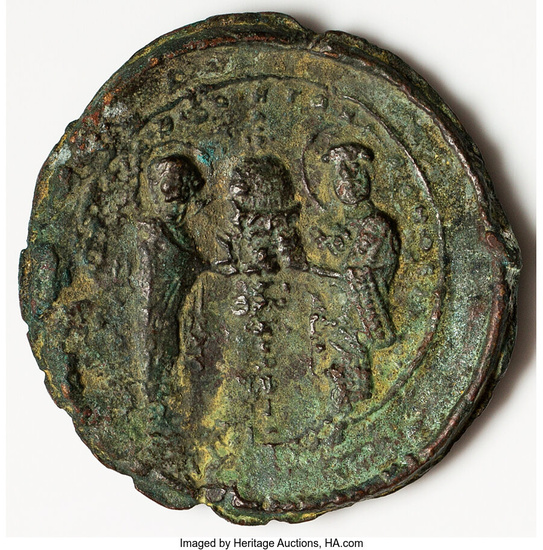Ancients: , Ekdikoi of the Hagia Sophia (AD 11th-12th centuries). Lead seal (57mm, 84.23 gm, 11h). XF, bent....
Ekdikoi of the Hagia Sophia (AD 11th-12th centuries). Lead seal (57mm, 84.23 gm, 11h). XF, bent. IOVCTINIAN ΔЄC ΘEOTOKE BOHΘEI, Theotokos and Justinian I, nimbate, standing facing, holding a model of the Hagia Sophia; H/A/Γ/I/A/C/O/Φ/I/A above and below, C-Φ across fields / + TOIC ΘE/O CEBCETA / TOIC ΠPEC/BVTEPOIC / KAI EKKΛH/CEKΔIK, leaf ornament above. Zacos II 70c. Green patina on chestnut surfaces. Slightly bent. Translation: Most holy Mother of God, help the most reverent priests and judges of Hagia Sophia. Commissioned by Emperor Justinian I, the Hagia Sophia stands as a significant emblem of the Byzantine Empire's architectural grandeur and cultural power. Constructed in 537 AD, it was envisioned to outshine the Temple of Solomon in Jerusalem, reflecting Justinian I's aspirations for his reign and the empire. With this remarkable monument, Justinian sought to emphasize Orthodox Christianity's dominance and his own divine authority. Hagia Sophia's colossal dome, a significant engineering achievement of the era, boldly testified to these ambitions, as did its opulent mosaics and marble pillars. Moreover, Herbert Frank states in his book 'The Justinian Code': "In Hagia Sophia, we are presented with Justinian's vision of heavenly order on earth." Thus, the Hagia Sophia represents Justinian I's unparalleled influence in shaping Byzantine arts, culture, and statecraft, its enduring legacy providing a fascinating glimpse into the grand ambitions of one of history's noteworthy empires. HID10510052018 © 2024 Heritage Auctions | All Rights Reserved
[ translate ]View it on
Sale price
Time, Location
Auction House
Ekdikoi of the Hagia Sophia (AD 11th-12th centuries). Lead seal (57mm, 84.23 gm, 11h). XF, bent. IOVCTINIAN ΔЄC ΘEOTOKE BOHΘEI, Theotokos and Justinian I, nimbate, standing facing, holding a model of the Hagia Sophia; H/A/Γ/I/A/C/O/Φ/I/A above and below, C-Φ across fields / + TOIC ΘE/O CEBCETA / TOIC ΠPEC/BVTEPOIC / KAI EKKΛH/CEKΔIK, leaf ornament above. Zacos II 70c. Green patina on chestnut surfaces. Slightly bent. Translation: Most holy Mother of God, help the most reverent priests and judges of Hagia Sophia. Commissioned by Emperor Justinian I, the Hagia Sophia stands as a significant emblem of the Byzantine Empire's architectural grandeur and cultural power. Constructed in 537 AD, it was envisioned to outshine the Temple of Solomon in Jerusalem, reflecting Justinian I's aspirations for his reign and the empire. With this remarkable monument, Justinian sought to emphasize Orthodox Christianity's dominance and his own divine authority. Hagia Sophia's colossal dome, a significant engineering achievement of the era, boldly testified to these ambitions, as did its opulent mosaics and marble pillars. Moreover, Herbert Frank states in his book 'The Justinian Code': "In Hagia Sophia, we are presented with Justinian's vision of heavenly order on earth." Thus, the Hagia Sophia represents Justinian I's unparalleled influence in shaping Byzantine arts, culture, and statecraft, its enduring legacy providing a fascinating glimpse into the grand ambitions of one of history's noteworthy empires. HID10510052018 © 2024 Heritage Auctions | All Rights Reserved
[ translate ]


